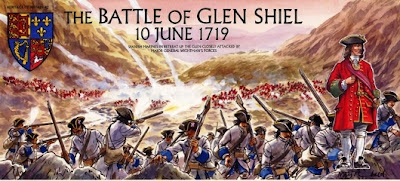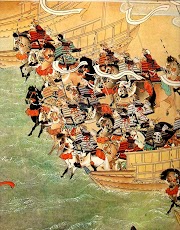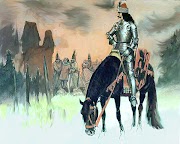British stamp collection cover of the Spanish "Galicia" regiments' retreat at the Battle of Glen Shiel, June 10th 1719
James Francis Edward, the Old Pretender. Had he ascended to throne he would have been King James III of England and Ireland and James VIII of Scotland
The first Jacobite War of 1715-1721 was decided primarily in the years 1715-1716, the conclusion of any major Jacobite resistance ending at the Battle of Sheriffmuir in 1715. The conflict was renewed however with the Glen Shiel campaign, the “Old Pretender” Prince James leading at the head of a Scottish-Jacobite army for just two months in early 1716. He would flee for France in defeat where he was denied refuge, moving to Papal territory soon after where the Jacobite pretender and his heirs would enjoy the hospitality of the Popes in Rome for the rest of their lives.
Scottish Jacobites ready for a Highland Charge in 1715
The impetus for Spanish involvement in the Jacobite cause came at the behest of the Italian cardinal and Spanish politician Giulio Alberoni (b.1664-1752), who believed that a Jacobite (Catholic) uprising in Scotland would forestall or even cancel British plans to attack Spain and its territories in the upcoming war. It was cardinal Alberoni who promised "Five thousand men, of which four thousand are to be foot, a thousand troopers, of which three hundred with their horses, the rest with their arms and accoutrements, and two months pay for them, ten field pieces, and a thousand barrels of powder and fifteen thousand arms for foot, with everything necessary to convey them” to the Jacobites in November of 1718. [1]
Storms either destroyed or waylaid the 29 Spanish ships sent toScotland lead by James Butler, the 2nd Duke of Ormonde (b.1665-1745) in March of 1719; it by then already clear that the Old Pretender would not be joining his supporters in Scotland for yet another rebellion for his cause. Even into late May the Jacobites were unaware of the destruction of the Spanish fleet, counting on the manpower and ships in the armada of the Duke of Ormonde to help them raise an even large Jacobite army to march on Inverness.
Storms either destroyed or waylaid the 29 Spanish ships sent to
Opposing Forces, the Jacobites and their Spanish Allies vs. George’s Hanoverian army
Jacobite leadership in the field was led by several men all with similar roles and backgrounds including the experienced and ever-capable Lord George Murray, the Marquess of Tullibardine Lord William Murray, Lord George's eldest brother, William Mackenzie the Earl of Seaforth, and George Keith, 10th Earl Marischal. Robert Roy MacGregor (b.1671-1734) the famed highland folk-hero and one-time reiver (cattle thief) was a committed Jacobite as well, a proscribed outlaw following the Risings of 1715.
All of the leading Jacobites brought their kin numbering perhaps more than 1000 fighting men and their servants, tacksmen (retainers or vassals), and their manrent (tenants who owned no land) from clans Cameron, Keith, MacGregor, Mackinnon, and Murray as well as several other smaller cadet branches. The Jacobites base of operations during the Little Rebellion was at Eilean Donan castle which was later bombarded and partially destroyed by three Hanoverian warships, theWorcester , Enterprise , and Flamborough after the Jacobites and their Spanish allies had marched south. [2]
All of the leading Jacobites brought their kin numbering perhaps more than 1000 fighting men and their servants, tacksmen (retainers or vassals), and their manrent (tenants who owned no land) from clans Cameron, Keith, MacGregor, Mackinnon, and Murray as well as several other smaller cadet branches. The Jacobites base of operations during the Little Rebellion was at Eilean Donan castle which was later bombarded and partially destroyed by three Hanoverian warships, the
Bombardment of Eilean Donan
Many of these pro-Jacobites soldiers had fought as reivers (livestock thieves) and highland bandits previously, some but very few may have been veterans of the previous Jacobite rebellions as Rob Roy had been, he and his father fighting in the First Jacobite rebellion of 1688-1689, when John Graham of Claverhouse, the Viscount Dundee known also ‘Bonnie Dundee’, revolted after the events of the Glorious Revolution in 1688 which deposed King James II and James VII of England & Scotland.
In many of the later ‘Wars of Three Kingdoms’ (England, Scotland, and Ireland) in 1639-1651 and into the later Jacobite era, the Highland charge of broadswords wielding Scots broke many infantry lines and won many battles for the sometimes outnumbered and frequently divided clans of the highlands and lowlands. One notable example of a successfulHighland charge was at the Battle of Killiecrankie in July 1689 where Bonnie Dundee won the battle but lost his life in the process a succesful Highland charge.
In many of the later ‘Wars of Three Kingdoms’ (England, Scotland, and Ireland) in 1639-1651 and into the later Jacobite era, the Highland charge of broadswords wielding Scots broke many infantry lines and won many battles for the sometimes outnumbered and frequently divided clans of the highlands and lowlands. One notable example of a successful
Lord George Murray, sixth son of John Murray the Duke of Atholl, who had supported King William III in the Glorious Revolution
The surviving Spanish contingent who fought with their Jacobite allies at Glen Shiel consisted of less than 230 infantrymen of the Regimento numero 3 La
Portrait of King George I of Great Britain (b.1660-1727)
The Battle of Glen Shiel was fought in a valley near the ‘drovers’ road’ by the River Shiel about half way up the valley where the Jacobites held the high ground with barricades, breastworks, and fortifications in the natural cover of the slopes of the mountain. This area sat across from a smaller glen, essentially a deep valley or a crag with a river flowing through it. The greater area of mountainsides nearby are called the Five Sisters Hills. During the battle the Jacobites held the road and the mountains north of the river.
General Wightman’s royal army, 1100 strong, made contact with Lord George Murray’s pickets’ first, skirmishing and exchanging musket fire whilst both armies scrambled into position. Eventually his mortars began to bombard the exposed Jacobite flanks whilst loyalist highlanders led by Sir George Munro of Culcairn attempted a charge up the hill at Murray ’s men.
Munro was wounded and may have been killed had his own man not protected him; in a series of firefights which later ensued many of the Jacobites were wounded including Rob Roy, the Earl of Seaforth, and later Lord Murray as well. The Spaniards were eventually bombarded as well, remaining brave and unwavering despite the intense shelling. The location where they fought being known as the ‘Pass of the Spaniards’ there after. The Jacobite line broke slowly at first but soon Seaforth and Rob Roy had fled field with their army, the rebel army broken before 8 PM in the evening under the vicious government assault. [4]
Munro was wounded and may have been killed had his own man not protected him; in a series of firefights which later ensued many of the Jacobites were wounded including Rob Roy, the Earl of Seaforth, and later Lord Murray as well. The Spaniards were eventually bombarded as well, remaining brave and unwavering despite the intense shelling. The location where they fought being known as the ‘Pass of the Spaniards’ there after. The Jacobite line broke slowly at first but soon Seaforth and Rob Roy had fled field with their army, the rebel army broken before 8 PM in the evening under the vicious government assault. [4]
Battle of Glen Shiel, Major General Wightman in the center in blue
King George’s army had won under Majr. Gen. Wightman suffering 21 men killed and 121 wounded, the Highlanders suffering perhaps double that number though they fled in good order to fight again or to escape with their lives into the highlands for a life of hardscrabble living. The Scots-Jacobites war council escaped intact, the surviving Spaniards were captured and offered generous terms and were eventually allowed to return to Spain.
Sharp notes that of “the men who had provided leadership in Glenshiel had mixed fortunes. After fighting in the last Jacobite rebellion of 1745, Tullibardine was executed in the Tower of London Prussia to good effect-the earl became a Prussian ambassador, and Keith attained the rank of marshal, dying in 1758 at the Battle Sardinia 's army before his brother intervened with the Hanoverian court to grant him a pardon in 1726. Although he had misgivings over the 1745 rebellion, he was appointed lieutenant general of the Jacobite army. He became the outstanding Jacobite commander in that rebellion, winning victories at Prestonpans and Falkirk and tactfully managing the retreat from Derby Battle
The Old Pretender learned too late the fate of both the failed Spanish expeditionary force and the defeat of the Scottish Jacobites at the Battle of Glen Shiel on June 10, 1719, ironically the day of his birth. Later in the same year the exiled prince was to be married, his wife Maria Clementina Sobieski a granddaughter of King John Sobieski III (b.1629-1695), the great hero of the Battle of Vienna in 1683. She gave birth a year later in 1720 to the "Young Pretender" known to history as Bonnie Prince Charlie. As a young ambitious man he would led the great but ultimately blundered Rebellion of 1745-1746, winning infamy at the bloody Battle of Culloden in 1746.
The Young Pretender in Highland Dress from a 19th century depiction


+(1688-1766)+Jacobite+claimant+to+the+thrones+of+England,+Scotland,+and+Ireland.jpg)










